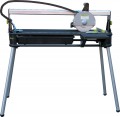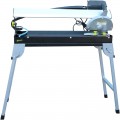Bore diameter
The diameter of the mounting hole on the cutting disc that the tile cutter is compatible with. This parameter is important when searching for and purchasing interchangeable working nozzles: the diameters of the mounting hole on the tile cutter and on the disk must match.
Cutting length
The longest cut that can be made with a tile cutter.
This parameter is relevant primarily for manual tile cutters, as well as for electric stationary units with a top disc feed. In such tools, the cutting element moves along the guide rail and has limited space for movement, and the length of the cut is, in fact, the length of the stroke of the cutting tool from one extreme point to the other. In fact, this is the maximum width of the material that can be cut with a tile cutter.
Cutting depth
The greatest depth to which the tool can cut through the material being processed, in other words, the maximum thickness of the tile that the tile cutter is guaranteed to be able to cut.
It is worth choosing a tool for this parameter taking into account the thickness of the material with which to work, plus some margin “just in case”. But this margin should not be too large: for a
deep cut, large discs and high power are required, which accordingly affects the price, weight and dimensions of the tool.
Side platform
The presence of
a side platform in the design of the tile cutter.
Such a platform is found mainly in electrical stationary units (see "Type"). It looks like a small platform, "extending" the main working platform to the side of the cutting line. This provides additional support for the cut tile, which is especially important when cutting large pieces: without a side platform, such fragments have to be supported by hand in order to avoid falling and damage, and this is not very convenient.
Table dimensions
The size of the working surface of the stationary tile cutter (see "Type"). The larger the table, the lower the likelihood that the tiles will hang from it during operation.

